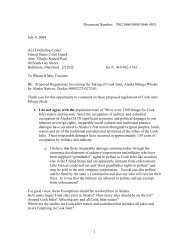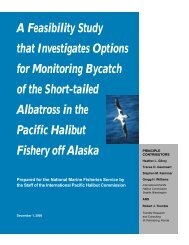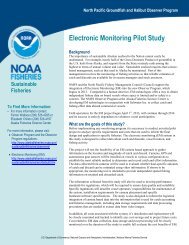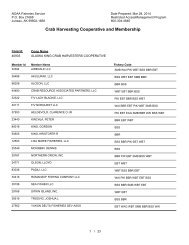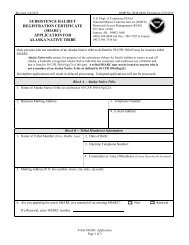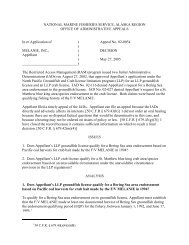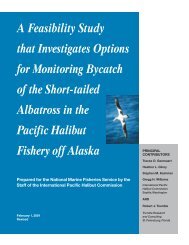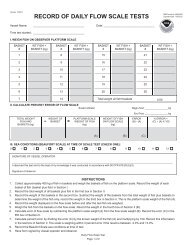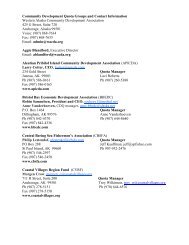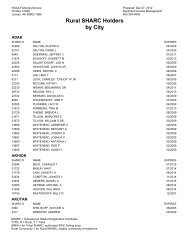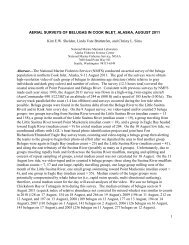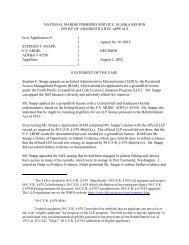Petition to List Lynn Canal Pacific Herring under the Endangered ...
Petition to List Lynn Canal Pacific Herring under the Endangered ...
Petition to List Lynn Canal Pacific Herring under the Endangered ...
You also want an ePaper? Increase the reach of your titles
YUMPU automatically turns print PDFs into web optimized ePapers that Google loves.
Cascade Point and adjacent areas of Berners Bay are within primary spawning grounds<br />
for <strong>the</strong> depressed <strong>Lynn</strong> <strong>Canal</strong> herring s<strong>to</strong>ck. Development of a marine facility here may<br />
have a negative impact on this herring resource. Vessel traffic, increased access,<br />
transient lighting, turbidity changes, <strong>the</strong> presence of hydrocarbons in <strong>the</strong> water and <strong>the</strong><br />
potential for oil and/or gas spills are all concerns. Additionally, since spawning herring<br />
are believed <strong>to</strong> target inter tidal and sub tidal kelp <strong>to</strong> deposit eggs, reduced kelp<br />
abundance or variety would directly affect spawning success. Department records of <strong>the</strong><br />
area since 1971 document herring spawn between Sawmill Cove and <strong>the</strong> Berners Bay<br />
flats in most years with few exceptions. The consistent herring spawn along this<br />
shoreline for <strong>the</strong> last 20 years is indicative of its importance <strong>to</strong> this s<strong>to</strong>ck. Continued<br />
encroachment on <strong>Lynn</strong> <strong>Canal</strong> shoreline that has his<strong>to</strong>rically been used for herring<br />
spawning may potentially have cumulative effect leading <strong>to</strong> <strong>the</strong> <strong>to</strong>tal collapse of <strong>the</strong><br />
herring resource in this area. This could reduce forage for large preda<strong>to</strong>rs such as<br />
salmon, sea lions, whales, and seals that inhabit <strong>Lynn</strong> <strong>Canal</strong>, with unknown<br />
ramifications.<br />
(ADFG 2004). The decline in spawning habitat was predicted by USFWS and NMFS personnel<br />
at least as far back as 1980.<br />
A large portion of <strong>the</strong> coastline in <strong>the</strong> vicinity of <strong>the</strong> Cowee – Davis Management Area is<br />
herring spawning habitat. We believe that it is vitally necessary <strong>to</strong> protect such habitat in<br />
order <strong>to</strong> manage <strong>the</strong> herring resource. At this time, <strong>the</strong> best method we have for<br />
determining what is herring spawning habitat is by observing <strong>the</strong> frequency of spawning<br />
use. This indicates a preference for a particular are by <strong>the</strong> herring. Habitat alteration and<br />
man-induced disturbances in frequently used spawning areas can adversely impact future<br />
utilization. This appears <strong>to</strong> have occurred in Auke Bay where once herring used <strong>to</strong> spawn<br />
throughout <strong>the</strong> area (Figure 10) and now utilize just a very limited section near Auke<br />
Cape (Figure 11). Evidence does not exist <strong>to</strong> show that <strong>the</strong>se displaced fish spawn in<br />
new areas. In addition, when spawning does take place on unsuitable artificial substrate<br />
such as boat hulls and petroleum saturated objects, significant egg mortality can result<br />
thus adversely affecting annual population recruitment.<br />
In <strong>the</strong> context of determining habitat value based upon frequency of utilization, <strong>the</strong> <strong>Lynn</strong><br />
<strong>Canal</strong> coastline from Auke Bay <strong>to</strong> Point St. Mary (Berners Bay) is <strong>the</strong> single most<br />
important stretch of spawning habitat <strong>to</strong> <strong>the</strong> <strong>Lynn</strong> <strong>Canal</strong>/Auke Bay herring s<strong>to</strong>ck. This<br />
particular area receives <strong>the</strong> most concentrated herring spawning activity in <strong>Lynn</strong> <strong>Canal</strong><br />
(Figure 11). To date, <strong>the</strong> spawning area locations charted by Skud in Figure 10 are still<br />
applicable, with <strong>the</strong> exception of Auke Bay as previously noted (D. Ingledue, ADF&G,<br />
pers. comm., 1980). The <strong>Lynn</strong> <strong>Canal</strong>/Auke Bay herring s<strong>to</strong>ck is a discrete population<br />
distinguishable by <strong>the</strong>ir concentration for overwintering in Auke Bay and Fritz Cove<br />
(Carlson 1980). The location of this wintering are probably accounts, in part, for <strong>the</strong><br />
geographic proximity of <strong>the</strong> observed major spawning grounds. We believe that <strong>the</strong><br />
described spawning are will thus continue <strong>to</strong> be utilized as spawning habitat and that this<br />
will <strong>the</strong>refore require protection of certain coastal areas.<br />
(USFWS-NMFS 1980: 6-7)(emphasis added).<br />
15



